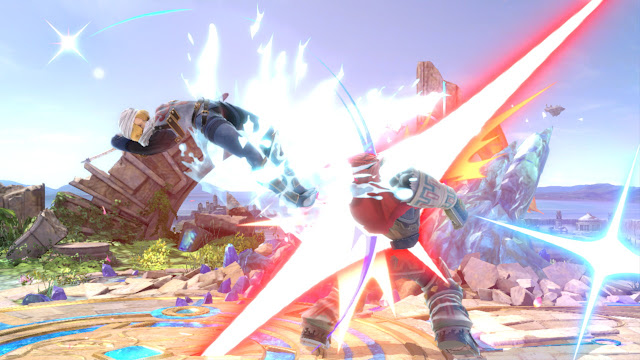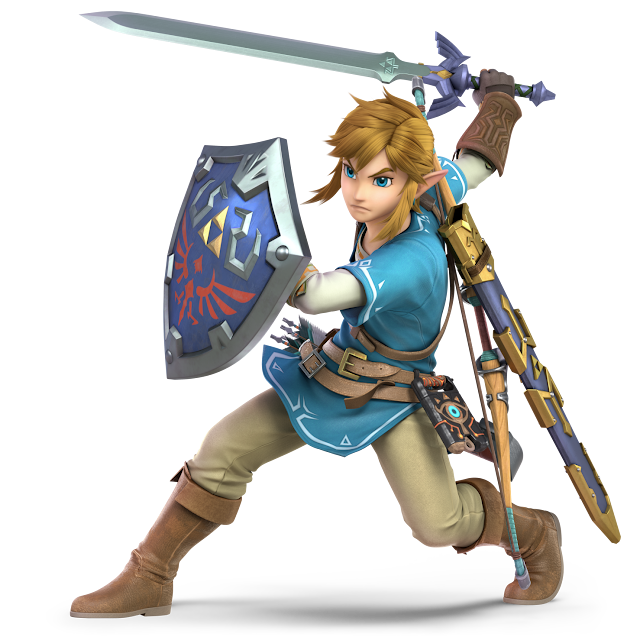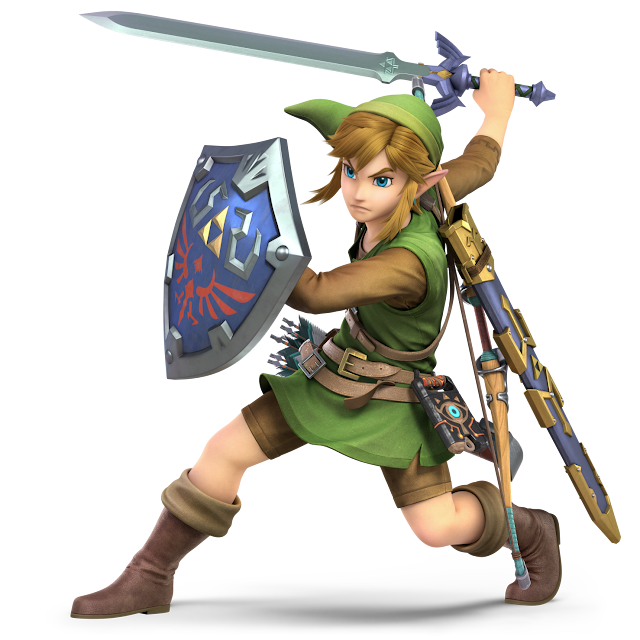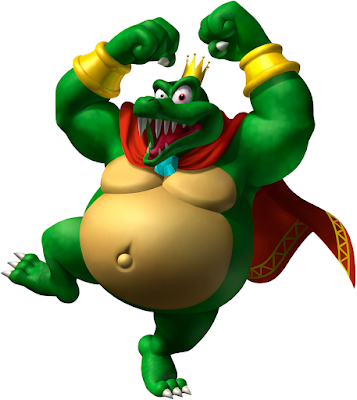Super Smash Bros. Fighters – Donkey Kong Series – 03 King K. Rool
Debut
In the Donkey Kong series: Donkey Kong Country (
1994)
In the Super Smash Bros. series: Super Smash Bros. Ultimate (
2018)
Boxing Ring Title: The Kremling Commander
Theme Song: Gang-Plank Galleon
King K. Rool is the main antagonist in the Donkey Kong series. He is the leader of the Kremlings, and often tries to steal the Kong's Banana Hoard to starve the Kongs, as well as attempt to conquer Donkey Kong Island. He also has a fondness for adopting various aliases and disguises when pulling off his many schemes.
King K. Rool makes his debut in
Donkey Kong Country. Prior to the events of the game, he and his Kremling Krew have attempted to steal the Banana Hoard from the Kongs many times, often to no avail. One night, the Kremlings are finally successful when Donkey Kong puts his little buddy, Diddy Kong, in charge of guarding the bananas as part of his "hero training." They manage to overwhelm the young monkey and haul the Banana Hoard back to K. Rool's ship: The Gangplank Galleon.
King K. Rool is fought at the end of the game at his ship, where he attacks them with cannonballs, charging at the duo, and throwing his crown. DK and Diddy manage to defeat him, after which the kredits roll... wait... "kredits?" That's right, King K. Rool uses a fake credits reel as a distraction, and once it ends, K. Rool gets back up to continue the fight! Despite his efforts, DK and Diddy manage to beat him again and reclaim the Banana Hoard.
In the Game Boy Advance remake of the game, after the real credits are done playing, he tosses Donkey Kong and his friends off of his ship and swears revenge, with Cranky Kong snarking that it sounds like a lame setup for a sequel.
As you can guess, he returns in
Donkey Kong Country 2: Diddy's Kong Quest. King K. Rool, now going under the alias "Kaptain K. Rool," and his Kremling Krew kidnap Donkey Kong while he was resting at the beach and transport him to their airship, The Flying Krock. He leaves a ransom note demanding that Kongs surrender the Banana Hoard to him before escorting DK to their home turf, Crocodile Island.
Inside The Flying Krock, Kaptain K. Rool beats up DK for a bit in front of Diddy and Dixie before turning his attention to them! The two manage to trounce him and celebrate, only for K. Rool to get back up and prepare a sneak attack! But before he can pull it off, DK breaks free from his bindings and sends K. Rool flying out of the ship and towards the sea, where the reptile ends up getting chomped on by some sharks until he manages to escape to Crocodile Island's Lost World.
Once Diddy and Dixie make it to the Lost World, Kaptain K. Rool engages the two in one last bout, which ends with him getting flung into the Krockodile Kore, which just so happens to be Crocodile Island's power source. As Crocodile Island sinks into the sea, a small raft is seen fleeing, with Kaptain K. Rool giving an ominous laugh.
King K. Rool has the same role in Game Boy Advance remake. However, as he escapes the sinking Crocodile Island on his raft, he begins to curse the Kongs for what they did. As he states he won't be stopped next time, Funky Kong drops a bomb on his raft, and K. Rool swears revenge.
King K. Rool then shows up in
Donkey Kong Country 3: Dixie Kong's Tripe Trouble where he now goes under the alias "Baron K. Roolenstein." Prior to the events of the game, he and the Kremlings manage to seal away the Banana Queen behind an evil barrier and scatter her Banana Birds every where throughout the Northern Kremisphere. Eventually, DK and Diddy arrive to go fishing in region's lake, which results in them being captured. K. Roolenstein then tosses the two inside of his new robot, KAOS, to power it up, before having the robot act as the Kremling's "current leader" to fool the Kongs that he was removed from power.
In the level, "Kastle Kaos," Dixie and her baby cousin Kiddy manage to defeat the robot, after which they discover that K. Roolenstein is indeed the croc behind the machine. He then engages the two in battle with his new helicopter pack to keep him afloat, but the two manage to best him, freeing DK and Diddy from inside KAOS. K. Roolenstein then flees to Kremetoa, with Dixie and Kiddy giving chase. There, he engages them in one last bout inside the Knautilus, which results in him losing once again.
If the player manages to rescue the Banana Queen - which requires rescuing all 15 Banana Birds - then a short scene plays afterwards of her chasing K. Roolenstein down before dropping a giant egg on him as revenge for trapping her.
King K. Rool also shows up in
Donkey Kong 64. Prior to the events of the game, K. Rool and his Kremling Krew manage to rebuild Crocodile Island as a technological fortress. Afterwards, K. Rool hires a man named Snide to help him build the Blast-O-Matic, a doomsday device that would be capable of destroying Donkey Kong Island with one blast! Once the machine was complete, King K. Rool fired Snide out of paranoia, then orders the Kritters to maneuver their base near Donkey Kong Island! Unfortunately, they end up crashing it into a rock, which badly damages the Blast-O-Matic. To buy them some time to repair it, K. Rool orders his minions to steal DK's Golden Bananas, as well as kidnap DK's friends.
Afterwards, K. Rool appears in certain cutscenes throughout the game, were he mostly comments on Donkey Kong and his friends's successes while chastising the Kremlings for their failures to stop the them. Once DK and his friends make it to Hideout Helm, the Kremlings manage to fix the Blast-O-Matic, with K. Rool ordering it to be fired immediately, regardless of the costs. Unfortunately for him, the Kongs manage to shut down the Blast-O-Matic. K. Rool tries to flee in an airship, only for K. Lumsy - a former member of the Kremling Krew, and possibly K. Rool's little brother - to backstab the crocodile king and crash the airship, allowing the Kongs to enter. Inside, they find that the ariship is shaped like a Boxing Arena. K Rool, now under his boxing alias "King Krusha K. Rool," challenges the heroes to a final battle.
King K. Rool also appears within the Donkey Kong Land trilogy. The first
Donkey Kong Land serves as a direct followup to
Donkey Kong Country, where Cranky calls up K. Rool and allows him to steal the Banana Hoard due a bet he made with DK and Diddy, saying that they wouldn't be able to reclaim them on the less-powerful Game Boy.
Donkey Kong Land 2 has the same story as
Donkey Kong Country 2: Diddy's Kong Quest.
Donkey Kong Land III sees K. Rool entering a contest to find the legendary Lost World, and he sends his Kremling Krew - as well as a rebuilt KAOS - to stop Dixie and Kiddy from finding it. When KAOS is defeated, K. Rool confronts the two himself on two separate occasions, though ultimately he ends up losing the contest in the end.
King K. Rool also stars as the antagonist in the DK series. In
DK: King of Swing, Donkey Kong and his pals are preparing to hold the Jungle Jam Tournament, where they will award various medals to the winners. The one who receives the most medals will be crowned the "Jungle Hero." Learning of this, King K. Rool arrives in his small hovercraft to steal all of the medals for himself, crowning himself the "Jungle Hero." After that, he flees with Donkey Kong pursuing him.
At the start of every world, K. Rool flies through the map while dropping some of the medals in the levels that DK will explore. K. Rool serves as the final boss in the game's fifth and final world, K. Kruizer III, in the level titled "King K. Rool." Here, the Kremling king challenges DK to a climbing race to the top. Once DK manages to beat him, K. Rool claims that it was just practice and battles DK. Despite his efforts, DK manages to best him again. King K. Rool's aircraft begins to blow up as DK escapes with all the medals.
K. Rool is also playable in the Jungle Jam Tournament Mode, serving as the largest and strongest of the playable characters. His partner for the tournament is Bubbles from the unrelated NES game, Clu Clu Land.
Also of note, this is the first game where King K. Rool isn't wearing the golden armor that covers his chest and stomach.
In
DK: Jungle Climber, King K. Rool learns of the Crystal Bananas, which are being held by an alien named Xananab who's currently residing at Sun Sun Island. Hoping that their powers would help him conquer the universe, he and five Kritters head there and manage to steal the five Crystal Bananas. Their celebration is cut short when they spot Donkey Kong, Diddy, and Cranky approaching from afar, forcing them to quickly flee via a dimensional portal device called Spirowarp.
Throughout the game, King K. Rool is encountered in various islands and dimensions. He expresses his annoyance at DK, Diddy, Cranky, and Xananab pursuing him.before having one of his Kritters use the powers of the Crystal Banana to try and defeat the Kongs. Once Donkey Kong manages to reclaim the fourth Crystal Banana, King K. Rool flees to Planet Plantaen, home of Xananab and his people. Chased into a dead end, he decides to fight DK and Diddy by using various methods, such as charging at them, and using explosive spike balls, though he ends up being defeated.
Refusing to accept defeat, King K. Rool decides to use the power of the Crystal Banana himself, transforming into a giant! In his new form, he attacks the two primates with new moves, such as breathing fire, exploding mines, summoning meteors of varying sizes, and trying to crush the two with his hands! Ultimately, Donkey Kong and Diddy manage to best the Kremling King again, and he reverts back to normal. Once the Kongs return the Crystal Banana to Xananab, they use a Banana Spaceship to ehad back home, all while dragging the unconscious K. Rool with them.
King K. Rool also shows up as a secret character in
Donkey Kong: Barrel Blast, unlocked after completing "Challenge #31: Showdown Vs. King K. Rool" from Candy's Challenges. Compared to the other racers, who are wearing Rocketbarrel Packs, King K. Rool rides on top of a Rocketbarrel Vehicle. His Boost, Speed, and Agility are all ranked 4/5, tying him with his rival Cranky Kong as the second-best character in the game.
King K. Rool's only outing in the Super Mario series is in
Mario Super Sluggers, where he sports an Egyptian theme. In the game's Story Mode, he resides in DK Jungle Stadium, where he tries to stop Mario, Donkey Kong, and their friends by sending four of his Kritters off to challenge them. Once they are defeated, he challenges them himself, only for his team to lose. Regardless, he's impressed by their skills, and decides to join them in their quest to stop Bowser.
King K. Rool can not be selected as a Baseball Captain. Instead, he serves as a Team Player. Of note is that he's on Donkey Kong's team by default. His justifications for doing so is because he was impressed by DK's skills at the game, and decided to call a truce. (at least when playing baseball, anyway.)
Personality-wise, true to what his name would imply, King K. Rool
is a rather cruel individual, as he tends to treat his subject poorly, especially if they're doing badly. The mistreatment of his troops does tend to backfire on him now and then. In Donkey Kong Country 2: Diddy's Kong Quest, Klubba hopes that Diddy and Dixie will foil his plans, while in Donkey Kong 64, K. Lumsy is implied to have given him a massive beat-down for locking him up earlier. Despite all this, the Kremling Krew still loyally follow him. Of particular note is that K. Rool is said to respect Kalypso's leadership skills, while being somewhat terrified of Kludge's strength.
King K. Rool is also shown to be a dirty fighter, often feigning his defeats to try and catch his foes off-guard. He also seems to be a bit of a showboater, and he is seen constantly showing off and taunting the Kongs throughout his battle in Donkey Kong 64. His motivation for stealing the Kong's Banana Hoard is said to be because he wants to starve the Kongs, as well as the fact that his Kremling Krew really love the nutritional value of the bananas. While it was initially said that K. Rool also loves bananas, DK: Jungle Climber reveals he actually despises them.
In Super Smash Bros., King K. Rool is ready to cause some havoc: Kremling-style! He may be somewhat slow, but he makes up for it with his immense strength, as well as his various tools and gadgets to give himself the edge over his foes!
Special Moves
Neutral Special: Blunderbluss
King K. Rool dons a Pirate hat and brings out the Blunderbluss,
shooting out a kannonball. Anyone hit by the kannonball takes damage.
If you hold the Special button after firing the kannonball, K. Rool
will begin trying to suck something or someone inside his Blunderbluss.
If it catches something, K. Rool can then fire it either diagonally in
front of him, diagonally behind him, or above him. Anyone who gets hit
by the flung character will also take damage.
In certain
occurrences, K. Rool can also suck up his own kannonball he shot and
refire it in either of the stated directions mentioned up above as well.
Inspired
by one of King K. Rool’s attacks in his boss fight in “Donkey Kong
Country 2: Diddy’s Kong Quest,” where he’d use the Blunderbluss to fire
Kannonballs – and even Spiked Kannonballs – at Diddy and Dixie.
Ironically, the way to defeat K. Rool was to throw the Kannonballs back
into his Blunderbluss, where it would cause the machine to explode. Looks like he worked out that bug.
Side Special: Crownerang
King K. Rool tosses his crown out in front of him, damaging anyone in
front of him. True to the name, the Crownerang comes back to K. Rool
after throwing it.
If, for some reason, the crown fails to return to K. Rool, it’ll land
on the ground. He'll have to go and pick it up himself if he wants to use
Crownerang again.
The opponent can also snag the crown and throw it back at King K.
Rool to damage him! Be careful, either try and dodge it, or try and grab it as they
toss it at you!
If the crown gets tossed offstage, it’ll teleport
back to the stage somewhere. If no one picks up the crown in a certain
amount of time, it’ll start to “disappear.” Once it does, it’ll return
back on top of King K. Rool’s head.
Inspired by one of King K. Rool’s attacks in “Donkey Kong
Country.” In that game however, Donkey Kong and Diddy Kong could not pick up
the crown, though they could jump on the King’s now-exposed head to
damage him.
Up Special: Propellerpack King K. Rool puts
on his Propellerpack and flies upward! K. Rool can go either forward or
backwards during his ascent. The blades will damage and somewhat drag
opponents up with K. Rool as well.
Inspired by his boss fight
in “Donkey Kong Country 3: Dixie’s Double Trouble,” where he used the
Propellerpack to mostly stay above Dixie and Kiddy during their battle.
Down Special: Gut Check
King K. Rool puffs out his stomach. His Golden Armor plates begin glowing.
Any small-brained fool who DARES to attack him while his armor is glowing will get bounced away from him and take damage!
This move can also reflect projectiles.
Seems to be
inspired by several instances of Kremling resilience. In “Donkey Kong
Country,” the golden armor on King K. Rool’s stomach makes him immune to
frontal assaults. Some Kremling enemies can shrug off front attacks,
and in some cases damage the Kongs. Another source of inspiration might
be the Klump enemies in “Donkey Kong 64,” as they use a similar move
when one of the Kongs approaches/bumps into them.
Final Smash: Blast-o-Matic King K. Rool
stomps his foot and charges forward at blinding speed! Anyone hit gets
flung to DK Island. King K. Rool then enters his greatest
invention, the Blast-o-Matic, and begins pounding the “FIRE” button over
and over while laughing like a maniac as the laser begins to charge.
Once it’s fully charged, the laser fires, damaging not only the helpless opponents, but also destroying DK Island! (
don’t worry, the island will get better!)
King
K. Rool and his opponent(s) then get teleported back to the stage they
were fighting on, with his opponent(s) getting flung away.
Inspired by the Game Over sequence of “Donkey Kong 64,”
where, upon either quitting the game, losing all of your lives, or
failing to destroy the Blast-o-Matic in time in the level “Hideout
Helm,” the player would be treated to a scene of King K. Rool laughing
in triumph as the Blast-o-Matic is now fully charged. With a press
of a button, DK Island and everyone on it is doomed, although
the game cuts away before the inevitable destruction takes place.
Additional Notes
King K. Rool has a unique gimmick:
Belly Super Armor!
Belly Super Armor allows K. Rool to tank any hit to his stomach while
performing certain moves, such as his Neutral-Ariel attack!
However, it can only block so much. As the Belly Armor takes more
damage, cracks begin to form, and eventually it won’t be able to block
another attack and will “shatter,” leaving King K. Rool open for attack.
His Belly Super Armor will slowly recover overtime, though. At it’s weakest, it takes about 47 seconds to fully recover.
You
don’t need to worry about the Belly Super Armor cracking when using Gut
Check, though, as Gut Check prevents cracks from happening.
During the development of
Donkey Kong Country, King K. Rool was
intended to go under the name of either “Krudd” or “Kommander,” but both of
these ideas were nixed. Gregg Mayles - character designer for
Donkey Kong Country - would also reveal some early concept for the character. He certainly looks different, huh?
When asked what the “K” in King K. Rool’s name stands for, Gregg Mayles
responded “Nothing! It
was just a way of making him seem more important, that he’d added it to
inflate his ego. In hindsight, it could have been something tonal like
‘Kremling’, or something deliberately out of character like Keith. What
do you reckon it should stand for?”



































































